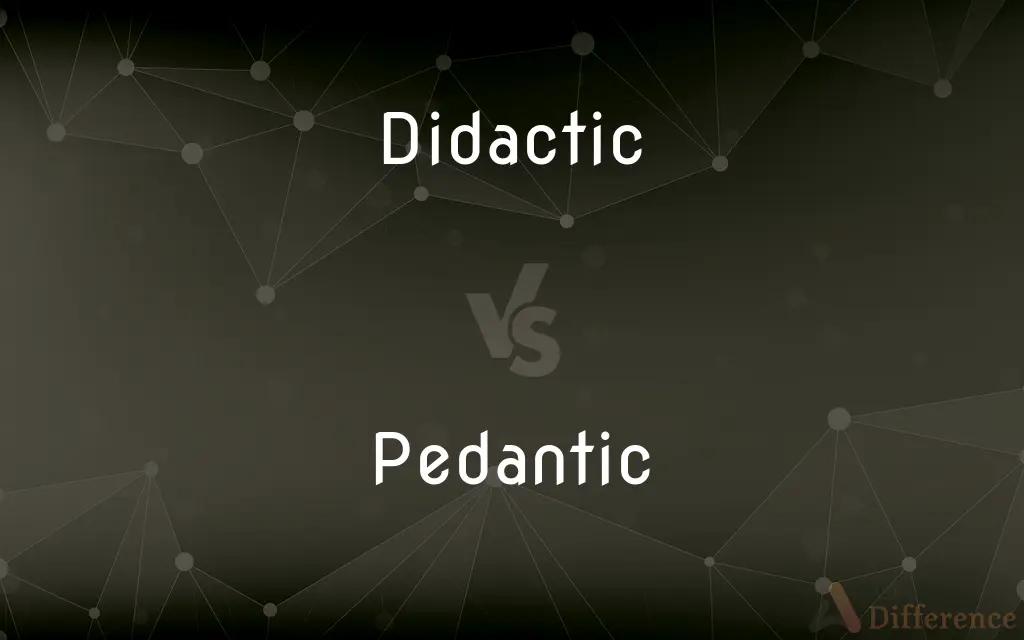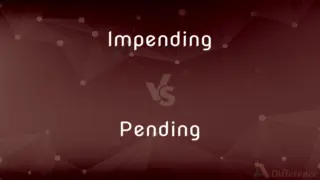Didactic vs. Pedantic — What's the Difference?
Edited by Tayyaba Rehman — By Urooj Arif — Updated on April 27, 2024
Didactic content aims to teach with an instructive purpose, whereas pedantic approaches risk overemphasizing minor details, often sounding overly scholarly.

Difference Between Didactic and Pedantic
Table of Contents
ADVERTISEMENT
Key Differences
Didactic materials are specifically designed to instruct or provide information, aiming to enhance the learner's understanding or skills. On the other hand, pedantic speech or writing can appear overly concerned with formal rules or trivial points of learning.
Teachers often use didactic methods to convey complex information in an educational setting, ensuring that the content is accessible and beneficial for students. Whereas, a pedantic person might focus excessively on minute details that do not necessarily contribute to the understanding of the subject.
In literature, a didactic approach can help illuminate moral or philosophical ideas to the reader through clear and practical examples. Conversely, pedantic writing might distract or even bore the reader with its emphasis on accuracy and exhaustive detail.
Didactic tools such as diagrams, interactive sessions, and straightforward explanations are often appreciated for their clarity and effectiveness in teaching. On the other hand, pedantic methods might involve lengthy discussions on minor technicalities, which can hinder the learning process.
While didacticism is appreciated in educational contexts for its straightforwardness and utility, pedantry is often criticized for being overly elaborate and lacking practical relevance.
ADVERTISEMENT
Comparison Chart
Purpose
To teach or instruct
To show off knowledge or learning
Focus
Broad and educational
Narrow and often trivial
Perception
Often positive in educational contexts
Frequently negative or annoying
Method
Uses clear and practical examples
Focuses on minute details
Audience Reception
Generally well-received
Often seen as overly detailed
Compare with Definitions
Didactic
Instructional in nature.
The museum's exhibits are didactic and designed to engage young minds.
Pedantic
Excessively precise and exact.
His pedantic attention to detail was not suitable for the fast-paced project environment.
Didactic
Involving a moral lesson.
The fable’s didactic message was clear and simple.
Pedantic
Showcasing trivial learning or knowledge.
The author’s pedantic references distracted from the narrative.
Didactic
Aimed at teaching or instructing.
The didactic program was developed to improve literacy among adults.
Pedantic
Overly concerned with formal rules or minor details.
His pedantic insistence on following the process exactly was frustrating.
Didactic
Educational and informative.
His didactic approach made learning enjoyable for children.
Pedantic
Scholarly in an ostentatious or tedious way.
The lecture was informative, but the speaker's pedantic tone made it dull.
Didactic
Conveying information or moral content.
The book is not only entertaining but also highly didactic.
Pedantic
Marked by a narrow focus on trivial aspects of learning.
Her pedantic approach to history overlooked the broader cultural impacts.
Didactic
Intended to teach, particularly in having moral instruction as an ulterior motive
A didactic novel that set out to expose social injustice
Pedantic
Excessively concerned with minor details or rules; overscrupulous
His analyses are careful and even painstaking, but never pedantic
Didactic
Intended to instruct.
Pedantic
Characterized by a narrow, often ostentatious concern for academic knowledge and formal rules
A pedantic attention to details.
Didactic
Morally instructive.
Pedantic
Being overly concerned with formal rules and trivial points of learning, like a pedant.
Didactic
Inclined to teach or moralize excessively.
Pedantic
Being showy of one’s knowledge, often in a boring manner.
Didactic
Instructive or intended to teach or demonstrate, especially with regard to morality.
Didactic poetry
Pedantic
Of or pertaining to a pedant; characteristic of, or resembling, a pedant; ostentatious of learning; as, a pedantic writer; a pedantic description; a pedantical affectation.
Didactic
Excessively moralizing.
Pedantic
Marked by a narrow focus on or display of learning especially its trivial aspects
Didactic
(medicine) Teaching from textbooks rather than laboratory demonstration and clinical application.
Didactic
(archaic) A treatise on teaching or education.
Didactic
Fitted or intended to teach; conveying instruction; preceptive; instructive; teaching some moral lesson; as, didactic essays.
The finest didactic poem in any language.
Didactic
Excessively prone to instruct, even those who do not wish to be instructed; - of people.
Didactic
A treatise on teaching or education.
Didactic
Instructive (especially excessively)
Common Curiosities
What defines a didactic approach in education?
A didactic approach is characterized by explicit teaching through lectures, instructions, and other educational materials aimed at facilitating learning.
Why might someone be perceived as pedantic?
Individuals are often perceived as pedantic when they focus excessively on trivial details or flaunt their knowledge unnecessarily.
How do didactic and pedantic approaches differ in their audience reception?
Didactic approaches are generally appreciated for their clarity and educational value, whereas pedantic approaches may be viewed as cumbersome and unnecessarily complex.
How can a pedantic attitude affect workplace communication?
A pedantic attitude can lead to communication breakdowns, as it often involves focusing too much on minor details rather than the overall message.
What skills are important for effectively delivering didactic content?
Clarity in presentation, the ability to engage the audience, and a good understanding of the subject matter are crucial for effective didactic delivery.
How can pedantry be a hindrance in social situations?
Pedantry can make social interactions tedious and irritating, as it might come off as showing off or nitpicking rather than contributing meaningfully to the conversation.
Can pedantic tendencies be beneficial in any professional fields?
In fields where precision is paramount, such as law or science, pedantic attention to detail can be beneficial, though it should be balanced with the need for practical application.
Is didactic teaching effective for all age groups?
Yes, didactic teaching can be adapted effectively for different age groups by varying the complexity and delivery of the educational content.
Can didactic methods be used outside traditional education?
Absolutely, didactic methods are also employed in professional training, public information campaigns, and other contexts where learning is a goal.
What is the main criticism of pedantic behaviors?
The main criticism is that they can be seen as overly detailed, focusing on precision at the expense of engaging or practical communication.
Can literature be both didactic and entertaining?
Yes, many works of literature manage to impart moral or educational lessons while also being engaging and entertaining.
In what situations is a didactic approach most beneficial?
A didactic approach is particularly beneficial in settings where clear, structured learning is required, such as in schools and training programs.
How does one balance being informative without being pedantic?
Balancing depth of information with the interests and needs of the audience is key to being informative without crossing into pedantry.
What are the benefits of using didactic tools in learning environments?
Didactic tools such as visual aids, practical demonstrations, and structured lessons can significantly enhance understanding and retention of information.
How can one avoid being pedantic in academic writing?
Focusing on the main argument and avoiding excessive detail on minor points can help keep academic writing concise and purposeful.
Share Your Discovery

Previous Comparison
Impending vs. Pending
Next Comparison
Exuberant vs. ExorbitantAuthor Spotlight
Written by
Urooj ArifUrooj is a skilled content writer at Ask Difference, known for her exceptional ability to simplify complex topics into engaging and informative content. With a passion for research and a flair for clear, concise writing, she consistently delivers articles that resonate with our diverse audience.
Edited by
Tayyaba RehmanTayyaba Rehman is a distinguished writer, currently serving as a primary contributor to askdifference.com. As a researcher in semantics and etymology, Tayyaba's passion for the complexity of languages and their distinctions has found a perfect home on the platform. Tayyaba delves into the intricacies of language, distinguishing between commonly confused words and phrases, thereby providing clarity for readers worldwide.














































